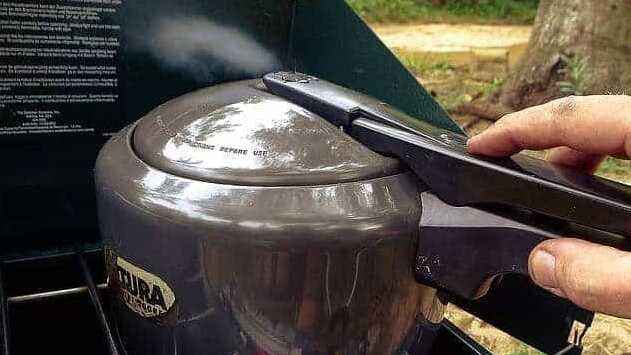FBISE QUESTION: Why do mountaineers carry with them pressure cooker?
OR
Why pressure cooker saves time in the kitchen?
EXPLANATION: Pressure cooker is equipped with a valve that controls the pressure inside the pot. This valve generally exerts a pressure of 2 atmospheric pressure. Therefore. the valve does not allow water vapors to escape until the pressure inside the pot reaches two atmospheric pressure (atm.). Because vapor pressure of water becomes two atm.(atmospheric pressure) when the temperature reaches 120 °C. So, water boils at 120 °C in a pressure cooker. That is why mountaineers carry with them pressure cooker to cook the food quickly.
FBISE QUESTION: Food cooked In ordinary kettles at higher altitude remains semi cooked why?
EXPLANATION: When the pressure of atmosphere is l atmospheric pressure or 101.325 kPa water boils at 100 °C at sea level. This is because at this temperature vapor pressure of water is 1 atmospheric pressure or 101 325 kPa. At Mount Everest al about 8850 m above sea level atmospheric pressure is only 34 kPa. So, water boils at this height above sea level. When its vapor pressure is 34 kPa at 70 °C. So, water boils at 70 °C. That is why food cooked in ordinary kettles at higher altitude remains semi-cooked.
FBISE QUESTION: Freeze-dried foods are light-weight and can be conveniently reconstituted by adding water. How?
EXPLANATION:
Ans: Freeze-drying is a dehydration process typically used to preserve a perishable material or make the material more convenient for transport. Freeze drying works by freezing the material and then reducing the surrounding pressure to allow the frozen water in the material to sublimate directly from the solid phase to the gas phase. This process is also called lyophilization .
FBISE QUESTION: How does diffusion differ from effusion?
OR
Compare diffusion and effusion of gases. Draw diagram keeping in view their molecular motions.
EXPLANATION: Difference between diffusion and effusion:
| Diffusion | Effusion |
| i. This movement of molecules from a higher concentration to a lower concentration is called diffusion. | i. The escape of gas molecules through the hole one after the other without collision is called effusion. |
| ii. In Diffusion the spontaneous flow of molecules from a region of higher concentration to a region of lower concentration. | ii. The reality is that molecules of the gas ore constantly colliding with the walls of the walls of the vessel. When they reach the walls and find a hole in ii then they pass through the hole. |
| iii. Diffusion takes place in all directions. | Iii. Effusion lakes place through a hole of molecular size. |
| iv. Example: The smell of rose or a scent spread due lo diffusion. | iv. Example: Escape of gas molecules from punctured tyre. |
QUESTION: Define pressure. What are the units of pressure? Convert 1 atm into kPa?
Pressure:
Force exerted by a gas on unit area of a container is called its pressure. All gases exert pressure. Al any point a gas exerts an equal pressure in all directions
1 atmosphere (1 atm):
At sea level at 0°C the atmospheric pressure is 760 mm of Hg or 760 torr This pressure is referred as one atmosphere.
so, 1 atm = 760mm Hg
= 760 torr
SI unit of pressure:
The SI unit of pressure is the pascal (Pa) which is very small unit, so that kilopascal (kPa) is used for atmospheric pressure under ordinary conditions.
Pascal:
One pascal equals force of one Newton exerted on an area of one square meter.
I atm= 101.325 kPa = 1.01325 x 105 Pa
Q6. Why gases are compressible?
Compressibility of gases:
Gases are highly compressible. This is due to the presence of large empty spaces between the gas molecules. On applying pressure distances between the gas molecules decrease, therefore, its volume decreases
QUESTION: Describe the effect on the volume of a gas by a change in pressure and temperature?
Effect on the volume of a gas by a change in pressure and temperature:
According to the kinetic molecular theory, gas molecules are in constant random motion. They move in straight line until they collide with another
molecule or the walls of the container. The pressure a gas exerts in o container is due to the force exerted on the walls of the container.
The average kinetic energy of gas molecules is directly proportional to the Kelvin temperature. (K.E 00 T)
Note: The average kinetic energy of a collision when a gas molecule collides with the wall of a container will not change when the pressure decreases at constant temperature.
Effect of pressure change on the volume of a gas:
There are large empty spaces between the molecules. On increasing pressure on the gas, the distance between molecules decreases. So, the volume of the gas decreases
MORE SOLUTIONS ARE GIVEN IN BELOW PDF
OPEN IN DRIVE (click)

